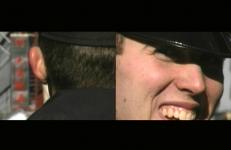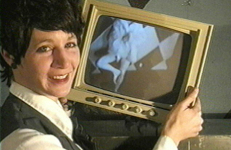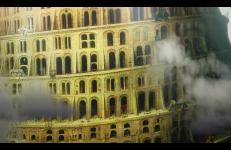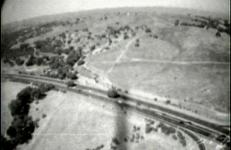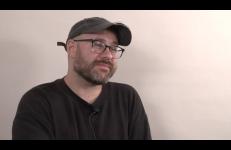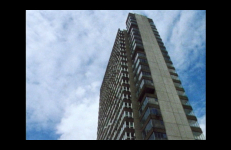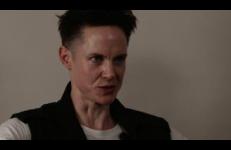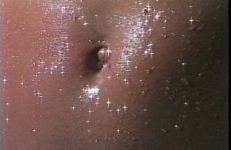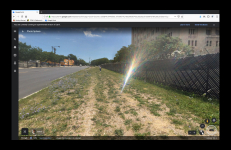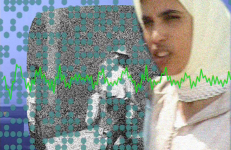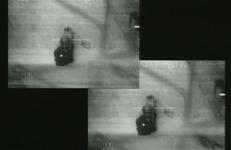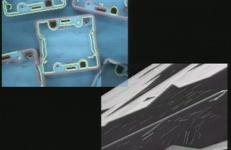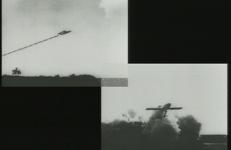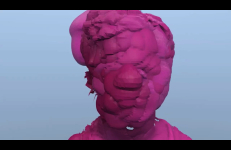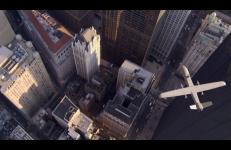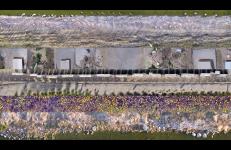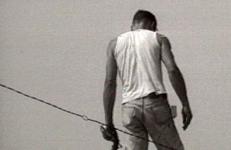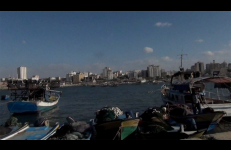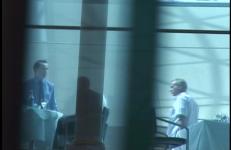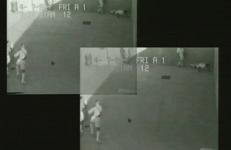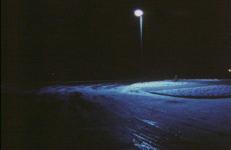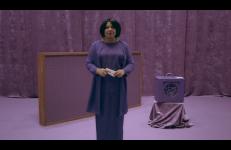"The world will devour you...."
A group of cops laugh and talk, while scanning the street for suspicious activity. An extreme close-up of a sensuously exposed neck; a soft pink fleshy ear turns to reveal an inquisitive hostile eye....
Surveillance
a/k/a Mrs. George Gilbert extends Coco Fusco’s in-depth examination of racialized imagery. Fusco combines fictional and documentary source materials to reflect on the use of electronic surveillance against Black intellectuals and activists in the 1960s and 1970s as part of covert FBI operations. These actions bear a striking resemblance to contemporary Patriot Act-inspired activities of American law enforcement.
Abscam (Framed) frames the FBI sting operation known as "Abscam" by mixing FBI surveillance footage of Congressman Michael "Ozzie" Meyers with footage shot by Lord at the Motel where the original sting occurred—in the process, inserting the artist into this moment in history.
A captivating video about surveillance, identity, watching, and being watched, The Amateurist slides along the edges of horror and satire to create an unsettling portrait of a woman on the brink of a technologically driven madness.
"The Amateurist has very few precedents--many films provoke laughter and tears, but few (only Chantal Akerman's early work and Todd Haynes Safe spring to mind) do so in a way that taps so directly into submerged contemporary anxiety."
Babeldom is a city so massive and growing at such a speed that soon, it is said, light itself will not escape its gravitational pull. How can two lovers communicate, one from inside the city and one outside? This is an elegy to urban life, against the backdrop of a city of the future, a portrait assembled from film shot in modern cities all around the world and collected from the most recent research in science, technology and architecture.
"It’s a complex architectural vision equal parts awesome and terrifying… This is a film – and city – to get lost in."
BIT Plane is a highly compact spy plane, wingspan 20 inches, radio-controlled, video-instrumented and deployed over areas of scenic interest. Due to its refined dimensions, BIT plane is able to enter territory inaccessible to other aircraft. Pioneering flight: in an aerial reconnaissance over the Silicon Valley, California 1997, BIT plane flew solo and undetected into the glittering heartland of the Information Age.
Zach Blas is an artist, writer, and filmmaker whose practice spans technical investigation, research, conceptualism, performance, and science fiction. Currently a Lecturer in the Department of Visual Cultures at Goldsmiths, University of London, Blas has exhibited internationally, including at the Walker Art Center, Gwangju Biennale, Los Angeles County Museum of Art, and Whitechapel Gallery.
Block is a round-the-clock portrait, shot over a duration of ten months, of a 1960s tower block in south east London. The film is a portrait that developed out of this long duration spent there. Patterns of activity around the block build a rhythm and viewing experience not dissimilar to the daily observations of the security guard who watches the flickering screens with their fixed viewpoints and missing pieces of action.
In conversation with David Getsy — an art historian focusing on queer and transgender methodologies in sculpture theory and performance history — Cassils discusses their monumental performance artworks and inspirations.
Susan Mogul's fantasies of success have always a comic, congenial twist, as in Dear Dennis, a video letter to Dennis Hopper inspired by her discovery that they share the same dentist. The central irony of this witty piece is that, despite Hopper's popular persona as an innovative, sub-cultural filmmaker and performer, the actual distance between his so-called independent" films and Mogul's experimental, non-commercial videos prevents Susan from finding any common ground from which to address Hopper other than the subject of dental work.
Cool sheets and warm male bodies ignite the screen with antics that go from hot pink to black and blue as they romp, stomp, spit and strut their "goods" before your eyes.
… Watch out – things get rough!
This title comprises Peek-A-Boo (2008), Litany of the Seven Kisses (2011), and Boy Toys (2000) which were compiled into this form by Mike Kuchar in 2022.
Frenzied voices on the Chicago Police Department’s scanner call for squad cars and reprisals during the 2020 uprising in response to the murders of George Floyd, Breonna Taylor, and Ahmaud Arbery, as Google Earth tracks the action through simulated aerial views of urban spaces and the vast Cook County Department of Corrections, the country’s third-largest jail system. In Christopher Harris’s Dreams Under Confinement, the prison, and the street merge into a shared carceral landscape.
Europlex tracks distinct cross-border activities through the Spanish Moroccan borderlands and seeks to make these obscure paths visible. On their repetitive circuits around the check-point to the Spanish enclave, the video follows in three borderlogs the smuggling women who strap multiple layers of clothes to their bodies, the daily commute of "domesticas" who turn into time travellers as they move back and forth between the Moroccan and European time zones and the Moroccan women working in the transnational zones in North Africa for the European market.
The film centers on the images of the Gulf War, which caused worldwide outrage in 1991. In the shots taken from projectiles homing in on their targets, bomb and reporter were identical, according to a theory put forward by the philosopher Klaus Theweleit. At the same time it was impossible to distinguish between the photographed and the (computer) simulated images. The loss of the 'genuine picture' means the eye no longer has a role as historical witness. It has been said that what was brought into play in the Gulf War was not new weaponry, but rather a new policy on images.
"How can the distinction between "man" and "machine" still be made given today's technology? In modern weapons technology the categories are on the move: intelligence is no longer limited to humans. In Eye/Machine II, Farocki has brought together visual material from both military and civilian sectors, showing machines operating intelligently and what it is they see when working on the basis of image processing programs. The traditional man-machine distinction becomes reduced to "eye/machine", where cameras are implanted into the machines as eyes.
“The third part of the Eye/Machine cycle structures the material around the concept of the operational image. These are images which do not portray a process, but are themselves part of a process. As early as the Eighties, cruise missiles used a stored image of a real landscape, then took an actual image during flight; the software compared the two images, resulting in a comparison between idea and reality, a confrontation between pure war and the impurity of the actual. This confrontation is also a montage, and montage is always about similarity and difference.
Facial Weaponization Communiqué: Fag Face protests against biometric facial recognition — and the inequalities these technologies propagate — by proposing the creation of “collective masks” that are modeled from the aggregated facial data of many faces, resulting in amorphous masks that cannot be detected as human faces by biometric facial recognition technologies.
Unmanned Aerial Vehicles — drones — have become an everyday feature of contemporary military activity, replacing humans in reconnaissance flights, small-scale combat missions and covert operations. The U.S. Army operates some ten thousands UAVs — a six-fold increase during Obama's term — deploying them over locations like Pakistan and Yemen.
Ground Effect is an investigation of the constantly shifting, 80km long line in Israel, where rainfall amounts to less than 200mm a year on average. This line, which aligns with the global desert belt, cuts from the east, near the West Bank, to the west, near the Gaza strip. It is where I grew up, an area divided between industrial scale agriculture, nature preserves, ancient and recent ruins, Bedouin towns, encampments and olive groves, artificial pine forests planted on contested lands, rural Jewish communities, and military practice zones.
Handy Man examines the window as a site of voyeurism and surveillance. With his Hi-8 camera, Henricks documents two workers in his interior courtyard. The camerawork has a secretive and furtive feel, treating the male body as an erotic object. This footage forms the basis of a video which attempts to implicate the viewer in processes of exhibitionism and image fetishization. Handy Man is part of a trilogy of works exploring one of the principle metaphors of video: the window.
Home Movies Gaza introduces us to the Gaza Strip as a mircrocosm for the failure of civilization. In an attempt to describe the everyday of a place that struggles for the most basic of human rights, this video claims a perspective from within the domestic spaces of a territory that is complicated, derelict, and altogether impossible to separate from its political identity.
"... Basma Alsharif’s Home Movies Gaza, a film that captures the impossibly politicized domestic sphere of the Gaza Strip, under the constant hum and buzz of overhead drones."
How Little We Know of Our Neighbours is an experimental documentary about Britain's Mass Observation Movement and its relationship to contemporary issues regarding surveillance, public self-disclosure, and privacy. At its center is a look at the multiple roles cameras have played in public space, starting in the 1880's, when the introduction of the hand-held camera brought photography out of the studio and into the street. For the first time one could be photographed casually in public without knowledge or consent.
“Images from the maximum-security prison in Corcoran, California. A surveillance camera shows a pie-shaped segment of the concrete yard where the prisoners, dressed in shorts and mostly shirtless, are allowed to spend half-an-hour a day. When one convict attacks another, those not involved lay flat on the ground, arms over their heads. They know that when a fight breaks out, the guard calls out a warning and then fires rubber bullets. If the fight continues, the guard shoots real bullets. The pictures are silent, the trail of gun smoke drifts across the picture.
An uncompromising look at the ways privacy, safety, convenience and surveillance determine our environment. Shot entirely at night, the film confronts the hermetic nature of white-collar communities, dissecting the fear behind contemporary suburban design. An isolation-based fear (protect us from people not like us). A fear of irregularity (eat at McDonalds, you know what to expect). A fear of thought (turn on the television). A fear of self (don’t stop moving).
Incense Sweaters & Ice is a new feature film inspired by the idea that anything one does while being watched is a performance. The film follows three protagonists — Mrs. Queen Esther Bernetta White, Girl, and WB (“whiteboy”) — as they navigate the dramas of surveillance, moving between looking, being looked at, and remaining unseen. How does the ever-present potential image affect the way we act and the way we see ourselves? By examining how cinema now happens in real time, Syms works between the documented and the live to find the lie.




